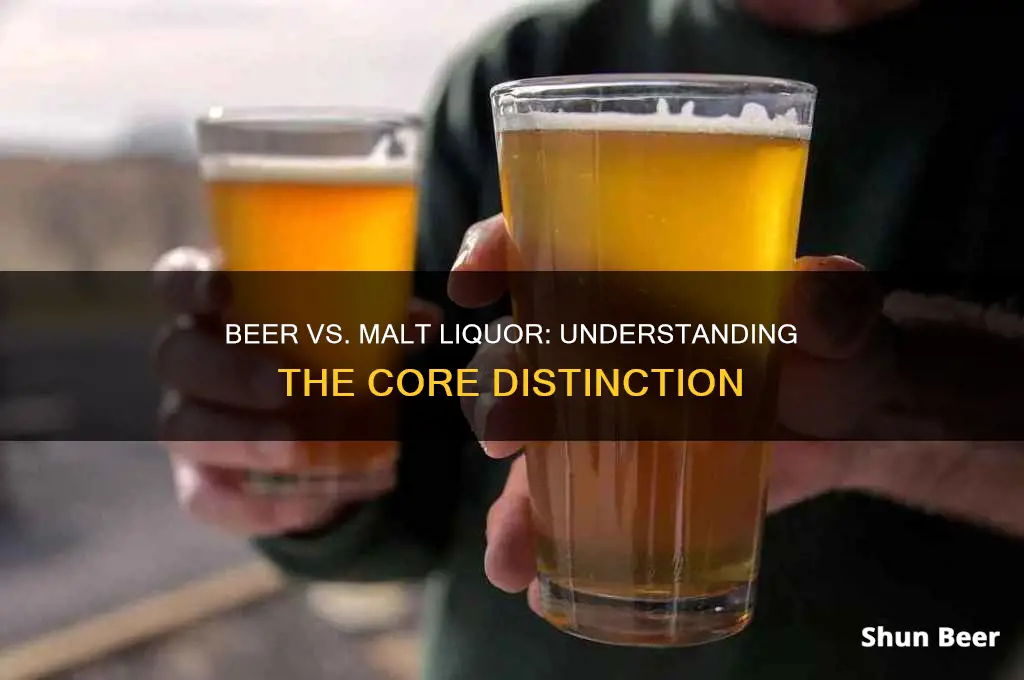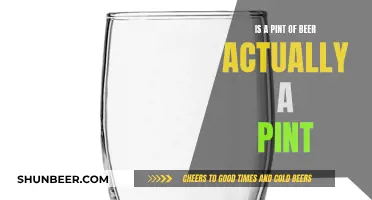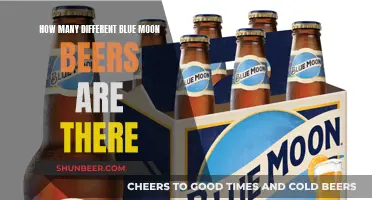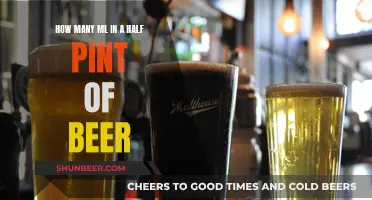
Malt liquor and beer are two alcoholic beverages that are often confused with one another. While they are produced similarly and share some ingredients, they have distinct differences in terms of brewing processes, alcohol content, flavour profiles, marketing strategies, and more. So, what sets these two drinks apart, and why do they cater to different consumer segments?
What You'll Learn

Alcohol Content
Beer and malt liquor differ significantly in their alcohol content. Beer typically has an alcohol content of between 4% and 5%, with some beers reaching upwards of 8%. However, malt liquor contains significantly more alcohol, with a volume alcohol level above 5% being considered malt liquor in the US. In fact, malt liquor can contain upwards of 12% alcohol, with some sources stating that it can contain as much as 20% alcohol. This higher alcohol content means that malt liquor can have a substantially stronger effect on the body compared to beer, and it is sometimes referred to as a "heavy" beer.
The higher alcohol content in malt liquor is achieved by adding more sugar during the brewing process, as more sugar leads to more alcohol. Brewers will often add adjuncts like corn, rice, or even pure white sugar to boost the total amount of fermentable sugars in the wort, which increases the final alcohol concentration. This results in a higher alcohol percentage than an average beer, with malt liquors typically ranging from 6% up to 9% alcohol by volume.
The legal definition of malt liquor often includes any alcoholic beverage with 5% or more alcohol by volume made with malted barley. However, this definition varies across different states and countries. For example, in Italy, beers with more than 14.5 Plato degrees are classified as birra doppio malto (double malt beer), which is the rough equivalent of North American malt liquor in terms of alcohol content.
It is important to note that the percentage of alcohol in a drink does not indicate the level of intoxication one will feel. Instead, it represents the amount of alcohol present in the beverage. Therefore, a drink with a higher percentage of alcohol will lead to intoxication faster, but all alcoholic beverages have the potential to cause the same level of intoxication.
Soju and Beer: What Sets Them Apart?
You may want to see also

Brewing Process
The brewing processes for beer and malt liquor share some similarities, but there are important differences in the ingredients used and the resulting alcohol content. Here is a detailed look at the brewing process for each:
Beer is an alcoholic beverage typically made from water, malted barley, hops, and yeast. The brewing process for beer involves several steps:
- Malting: The barley grains are soaked in water and allowed to germinate, producing enzymes that convert starches into sugars.
- Mashing: The malted barley is crushed and mixed with hot water to create a sugar-rich liquid called wort. This process extracts the sugars from the grains.
- Boiling: The wort is boiled, and hops are added for flavouring and preservation. Boiling also sterilises the mixture.
- Fermentation: Yeast is added to the wort, which feeds on the sugars and produces alcohol and carbon dioxide. This process can take several days to weeks, depending on the type of beer.
- Conditioning: The beer is then conditioned, which involves storing it at a cool temperature to allow the flavours to mature and any remaining yeast to settle.
- Packaging: Finally, the beer is packaged into bottles, cans, or kegs, ready for distribution and consumption.
Malt liquor is a type of beer with a higher alcohol content, typically above 5% or 6% alcohol by volume. The brewing process for malt liquor involves similar steps to beer, but with some key differences:
- Malting and Mashing: As with beer, malted barley is used, but malt liquor often includes a higher proportion of adjuncts such as corn, rice, or dextrose. These adjuncts add extra fermentable sugars to the wort, boosting the final alcohol concentration.
- Boiling: The boiling process is similar to that of beer, but malt liquor is not heavily hopped, resulting in a less bitter taste.
- Fermentation: Fermentation in malt liquor involves the addition of more sugar to achieve a higher alcohol content. This can result in alcohol levels of 12% or higher, and sometimes up to 20%.
- Conditioning and Packaging: The conditioning and packaging processes for malt liquor are similar to those of beer, but malt liquor is often sold in larger containers, such as 40-ounce bottles.
In summary, while the brewing processes for beer and malt liquor share some common steps, the key differences lie in the types and amounts of ingredients used, particularly the addition of adjuncts and extra sugar in malt liquor, which result in a higher alcohol content.
Beer Carbonation: Why the Fizz Differs
You may want to see also

Taste
While beer and malt liquor are both brewed from malted barley and hops, they differ significantly in terms of taste.
Beer is made from water, malted barley, hops, and yeast. Hops are added to provide a bitter flavor and act as a preservative. The malted barley in beer is typically "two-row" barley, which has a lower protein content. This contributes to the lighter texture and flavor of beer.
Malt liquor, on the other hand, contains more alcohol than standard beer, with a volume alcohol level above 5% in the US. This higher alcohol content is achieved by adding adjuncts like corn, rice, or sugar to the malted barley, boosting the amount of fermentable sugars in the wort. The use of these adjuncts gives malt liquor a sweeter flavor profile. The malted barley used in malt liquor is often "six-row" barley, which has a higher protein content, resulting in a denser, more viscous texture.
Malt liquor is also less heavily hopped than beer, resulting in a less bitter taste. The reduced use of hops, along with the addition of adjuncts, gives malt liquor a smoother, less carbonated mouthfeel.
While some people enjoy the full-bodied, sweet flavor of malt liquor, others may find it overpowering or excessively sweet. Beer, with its lower alcohol content and more balanced flavor profile, is often preferred for its refreshing and crisp characteristics.
In summary, the taste difference between beer and malt liquor can be attributed to the higher alcohol content and the use of adjuncts in malt liquor, resulting in a sweeter, stronger, and smoother beverage. Beer, on the other hand, offers a more bitter, carbonated, and lighter drinking experience.
Explore the Nuances: 3A Draft Beer vs Pilsner
You may want to see also

Marketing and Consumption
The marketing and consumption of malt liquor and beer differ significantly. Beer is often marketed as a fun and enjoyable beverage for social gatherings or dining, and it is commonly consumed in public spaces like bars and restaurants. On the other hand, malt liquor is typically marketed towards individuals seeking an inexpensive and quick way to get intoxicated. It is often associated with solitary drinking or consumption in less social settings.
The packaging and presentation of malt liquor also contribute to its distinct consumption patterns. It is usually sold in larger bottles or cans, with some brands offering 40-ounce or larger sizes. This packaging may suggest that malt liquor is intended for excessive or binge consumption. However, it is important to emphasise that moderate alcohol consumption is always advised.
Malt liquor has been the subject of controversy due to its targeted marketing towards specific demographics. Critics argue that the advertising in ethnic neighbourhoods, particularly African American and Latino communities, has contributed to its status as a symbol of machismo and a higher social standing. This has led to accusations of taking advantage of minority groups and exacerbating existing social issues within these communities.
The higher alcohol content of malt liquor has also drawn attention from policymakers and regulators. In the United States, malt liquor is often subject to stricter labelling requirements, higher taxes, and restricted sales hours or locations compared to beer. These measures aim to mitigate the potential adverse effects of malt liquor consumption on public health and safety.
The history of malt liquor marketing provides insight into the evolution of its consumption. Initially, marketers targeted white middle-class consumers, positioning malt liquor as a refined drink similar to cocktails or champagne. However, they eventually shifted their focus to low-income, predominantly non-white communities, emphasising the product's strength and value. This change in demographic targeting significantly influenced the marketing strategies and contributed to the perception of malt liquor as a "black business".
In conclusion, the marketing and consumption patterns of malt liquor and beer differ significantly. While beer is positioned as a social and enjoyable beverage, malt liquor is often associated with quick intoxication and solitary consumption. The larger packaging and higher alcohol content of malt liquor have also shaped its consumption patterns and attracted regulatory attention. The controversial marketing strategies of malt liquor have sparked debates about the impact on minority communities and public health.
Beer, Ale, Lager, Stout: What Sets Them Apart?
You may want to see also

History
Beer is one of the oldest human-produced drinks, with written records of its use in ancient Egypt and Mesopotamia. The drink has spread throughout the world, and a 3,900-year-old Sumerian poem honouring Ninkasi, the patron goddess of brewing, contains the oldest surviving beer recipe. Beer was also brewed in China around 5,000 years ago, and in Europe as far back as 5,000 BCE.
Malt liquor, on the other hand, is a more recent invention, emerging in the United States during the mid-1900s. It was born out of the desire for beer with more "kick", or higher alcohol content, than regular beer. The first malt liquor was brewed in the late 1930s or early 1940s, during a time when the Great Depression and World War II rationing made things difficult for brewers. Two brewers in the Midwest, Clarence "Click" Koerber of the Grand Valley Brewing Company in Ionia, Michigan, and Alvin Gluek of Gluek Brewing in Minneapolis, Minnesota, are credited with creating the first malt liquors: Clix Malt Liquor and Sparkling Stite, respectively.
In the early days, malt liquor was marketed as an upscale product, targeting the growing post-war middle class. It was advertised in magazines with neat, smiling white people, dressed up and enjoying themselves in a polite manner. However, despite these efforts, malt liquor failed to gain significant traction in the marketplace for almost 20 years.
That changed in 1963, when National Brewing in Baltimore, Maryland, introduced Colt 45. This new malt liquor was explicitly marketed for its higher alcohol content, featuring a label with a kicking horse and a horseshoe. This was a violation of federal law, which prohibited labels that could be considered statements of alcoholic content. Nevertheless, the Bureau of Alcohol, Tobacco and Firearms (BATF) approved the label, setting off a race among brewers to create their own brands with similar imagery evoking potency.
In the late 1960s and early 1970s, the Civil Rights movement prompted many American businesses, including brewers, to start advertising to Black Americans. This shift was driven by a combination of social conscience and the threat of boycotts. Malt liquor was already disproportionately consumed by Black Americans, and this new targeted marketing further solidified its association with this demographic.
By the 1980s, malt liquor was facing criticism for its perceived targeting of vulnerable communities. Brewers were accused of unethical and socially irresponsible behaviour, as the drink's higher alcohol content could exacerbate existing health disparities and poor access to medical care in these communities. Despite the controversy, malt liquor continued to be a popular and profitable product, with well-known brands such as Colt 45, St. Ides, and Olde English 800.
A Wide Variety of Beers at Yard House
You may want to see also
Frequently asked questions
Beer and malt liquor are both brewed from malted barley and hops, but the main difference lies in their alcohol content and ingredients. Malt liquor has a higher alcohol content, typically ranging from 5% to 9% ABV or even higher, while beer usually falls between 4% and 5% ABV. To achieve this higher alcohol level, malt liquor uses more sugar, often incorporating adjuncts like corn, rice, or even pure white sugar, resulting in a sweeter and less bitter taste.
Beer is typically made from water, malted barley, hops, and yeast. The malted barley is heated and mashed to release enzymes that convert starches into sugars. Hops are then added for bitterness and as a preservative, and finally, yeast is added to ferment the sugars and produce alcohol.
Malt liquor, on the other hand, is often made with cheaper, less flavorful ingredients, including additional grains like corn, rice, or wheat, which contribute to its higher alcohol content and sweeter taste.
While malt liquor is a form of beer due to its higher alcohol content and different ingredients, it is generally not considered a type of beer. Malt liquor is a distinct beverage with a stronger, sweeter, and less complex flavor profile compared to traditional beer.
Malt liquor is typically more expensive than beer due to its higher alcohol content. A standard serving of malt liquor contains more alcohol by volume, so you're paying for more alcohol per ounce. Additionally, malt liquor is often sold in larger containers, such as 16-ounce cans or even 40-ounce bottles, which further increases the price.
Yes, there are notable differences in the marketing and consumption patterns of beer and malt liquor. Beer is usually marketed as a fun and enjoyable beverage for social gatherings, dining, or casual drinking. On the other hand, malt liquor is often associated with solitary drinking or consumed in settings that are less convivial. Malt liquor is typically targeted at consumers looking for a quick and inexpensive way to get intoxicated, while beer is positioned as a more mainstream and sociable drink.







